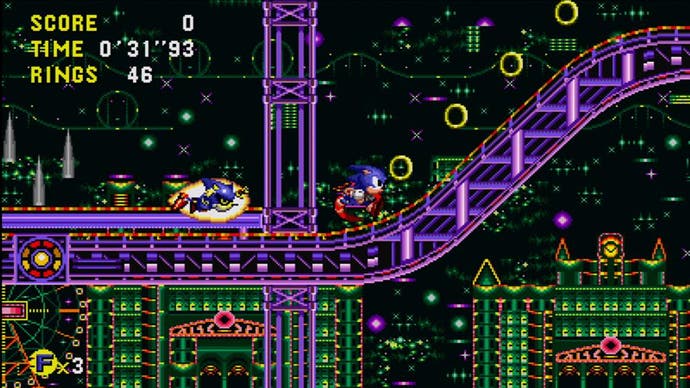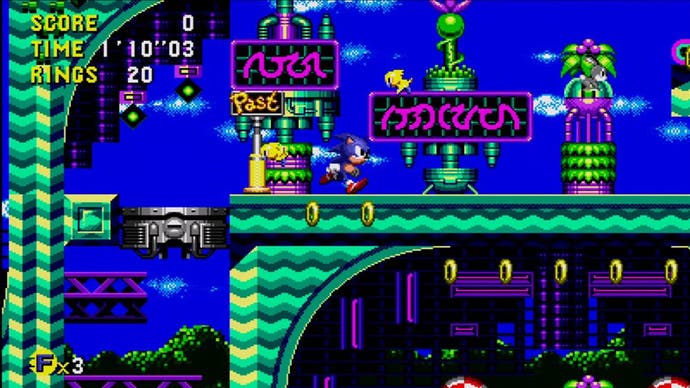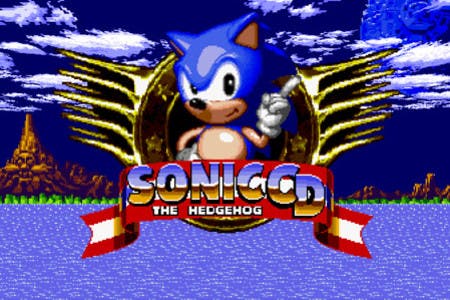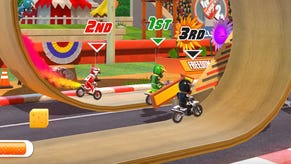Sonic CD Review
To be this good takes ages.
Sega is a shadow of its former self. Its star developers are scattered to the four winds while treasured series hang cracked and dry from so much tireless, often unsympathetic milking. The company is perhaps the greatest casualty in the collapse of the arcade scene, once the fertile breeding ground for its most daring ideas and brightest designers.
Nevertheless, Sega still has one jewel to its name: its fans. Sega's devotees are loyal and tenacious - and many are also talented and industrious. Nowhere is this fact more evident than in this remake of Sonic CD, a lavish, widescreen production that puts almost every other Japanese publisher who is remaking yesteryear's classics, from Treasure to Nintendo, to shame with its generosity. It was, in large part, made by a fan.
In 2009, after a number of somewhat disappointing iOS ports of classic Sega titles, the publisher put out a call to fans asking which game the community might like to see re-released next. Australian coder Christian Whitehead responded not with a wish list but rather with a YouTube video showing a proof-of-concept port of the classic Mega CD title Sonic CD, created with his own Retro Engine Development Kit.

The demo differed from the usual type of emulation seen on the 'jailbroken' market, as the screen had been carefully scaled to fit an iPod Touch, while the game itself ran at 60 frames per second. At the time, few emulated versions of the game ran at much more than 20.
Whitehead, a huge fan of Sonic CD, had created an entire SDK specifically for porting the game, in the hope that his work might inspire Sega to revisit what is widely regarded as the strongest title in the Mega CD catalogue. However, after a few weeks, Whitehead's website was taken offline, as was the YouTube video he released to show off his work. It seemed as though Sega's lawyers had issued a cease-and-desist and ordered his work to be scrapped.
Two years later and an official Sonic CD release surfaces bearing Whitehead's name. Sega had done what few multinational companies of its size, age and resulatant inflexibility could have: made a fan a creative asset.
Whitehead's engine is notable for its performance, which renders the Mega CD original with effortless accuracy. The window onto the action has been expanded for widescreen televisions, rather than stretched, ensuring the game feels as though it was designed for Xbox Live Arcade rather than awkwardly pulled apart to fill it. Both the original Japanese and American soundtracks are included (the latter replaced the Japanese original on US launch, much to the consternation of many fans), and the range of options runs deep and wide. But Whitehead's exemplary work extends further than mere aesthetics.
The RSDK also gives its designers the chance to tweak and refine levels as well as the underlying code. As such, the sometimes shoddy collision detection of the original has been fixed, while the control scheme of the Mega Drive's Sonic 2 replaces the less precise Mega CD game (although, of course, you have the option to switch between both). The new menu screens use the same fonts and assets as the originals, and at every turn this feels like the most sympathetic and conscientious re-release of a 20-year-old title yet seen on the digital platforms: a new benchmark for others to aim for.

That the game is being sold at 400 Microsoft Points - a price point long abandoned in the XBLA marketplace - is further evidence of Sega leading the way with this release in terms of offering more for less.
Despite its reputation as one of the stronger entries in the Sonic series, Sonic CD is less well known due to the commercial failure of its host console. It may share assets and a basic premise with other Sonic titles (save Amy and free the planet from Dr Eggman's control), but in many ways Sonic CD is atypical.
Following the release of the first game in the series, lead programmer Yuji Naka moved to America to work on Sonic the Hedgehog 2 with key members of Sonic Team. Meanwhile, in Japan, Sonic creator Naoto Ohshima began work on what would become Sonic CD, a game that rapidly found its own unique identity.
As with most titles in the Sonic oeuvre, Sonic CD lacks the clockwork precision of Miyamoto's Mario titles, instead placing heavier emphasis on thrilling, unpredictable physics and erratic rhythms that juxtapose high-speed circular saw rolls with juddering splangs off spikes. Stages are short and sharp, and each world is tailed with a simple boss fight, most of which lack sophistication or nuance. But - more so than elsewhere in the series - this is a platform game, filled with exploratory puzzles and non-linear rewards for those who venture off the beaten track.
What really marks Sonic CD out from its cousins is the central conceit of time travel, something fresh to the series (and unrepeated since). Signposts dotted through each stage are marked 'Past' or 'Future', and passing through one of these earns you a time travel energy token. Once you have one of these in your possession, you can jump back or forward in time by reaching maximum velocity for a few seconds.

Travelling back to a time before Dr Eggman took over Little Planet offers Sonic the chance to permanently change history by locating and destroying the robot polluter in the 'past' version of each stage. The best endings are earned only by travelling back in time at every opportunity and clearing levels in this altered state. Players who fail to pay much attention to this somewhat obscure mechanic may breeze through the game in a couple of hours, but they'll earn the bad ending while doing so.
It's an interesting system, but triggering the leap back in time can be frustrating, as many later stages make building up the Back To The Future-style required speed difficult. Combine this with some of the cruellest level design in the series (which often fires you from springs direct into off-screen ceiling-mounted spikes), and mining the game for its richest rewards can be unnecessarily exasperating.
However, there is no doubt that this is the definitive version of a little-known, much-loved title. Sega's humility in collaborating with Whitehead, and artistry in bringing the game's strengths to the fore, is a striking achievement in 2011. For that reason, for the first time in a long time Sega, deserves its richest asset - and for the first time in a long time, those fans deserve Sega.



